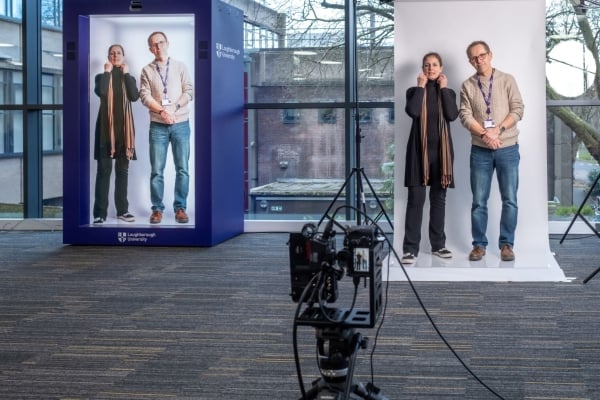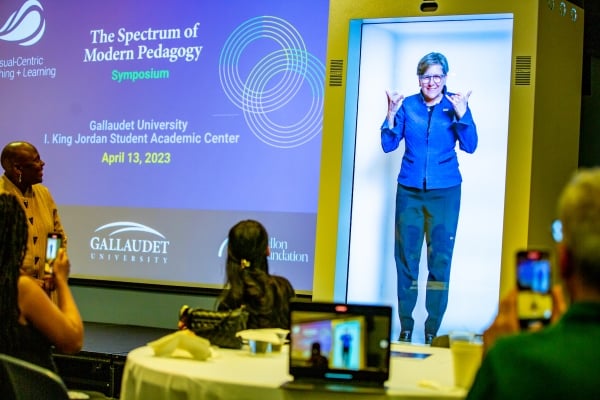You have /5 articles left.
Sign up for a free account or log in.

The University of Central Florida utilizes holograms for teaching and helping students to diagnose patients.
Bari Hoffman first learned of holograms during the pandemic, when she saw that rapper Diddy had beamed a full-body digital version of himself into a seven-foot-tall display box to remotely sing “Happy Birthday” to his son.
While the move made headlines for the quarantine connectivity and pricey technology, Hoffman, a professor at the University of Central Florida’s College of Health Professions and Sciences, envisioned a different application.
“I thought, ‘Imagine what we can do and expose our students to,’” said Hoffman, who also serves as an associate dean of clinical affairs.
Now, about three years later, medical and physical therapy students at UCF observe life-size virtual patients displayed in large hologram boxes. The technology allows students to go beyond the limits of flat computer screens, showing subtle patient signs such as quivering hands or a rapidly shaking leg.
“We’re used to seeing everyone in a Zoom window, and with telehealth, you lose a lot of the full-body image and also the subtle symptoms on traditional 2-D platforms,” Hoffman said. “Particularly, when we think of the conditions students need to treat, you have medically fragile patients you can’t always bring to class. We wanted students to be prepared.”
The UCF work is part of the slowly growing adoption of holograms in the classroom. While some institutions use the technology to bring in lecturers from around the world, others are training physicians or showcasing class projects in a new light.
However, even with these advances, questions remain about whether the technology will reach beyond science fiction movies and into mainstream education.
Holograms for College Lecturing, Telehealth
When discussing holograms, said Daniel Smalley, a professor of electrical engineering at Brigham Young University at Provo, most people picture Carrie Fisher’s Princess Leia or other Star Wars characters appearing as pint-size, digital projections.

Getty Images
Holography has fascinated Smalley since he was in middle school and stumbled across the definition in an encyclopedia.
“Whenever a filmmaker expresses they’re in the future, they have a figure in the air illuminated and may or may not call it a hologram,” Smalley said.
Actual holograms are more complicated, involving lasers, optics and 3-D imaging. By popular definition, holograms allow a person to “appear” in a room—in the case of UCF and other institutions, holograms display inside a large person-size box viewed at the front of a class or in a small box placed on desks.
The goal is to create a feeling of being in the same room as the holographic person or object, an experience known as co-presence, which proponents of hologram technology argue cannot be accomplished with video tools like Zoom.
“It’s not another digital thing to take our mind off the real world; we’re just making the real world easier to communicate in,” said David Nussbaum, CEO and founder of Proto Inc., one of the leaders in the university hologram space. He said his company is working with about 40 institutions.
Gary Burnett, among the first European professors to use the technology, wants to use holograms to bring students’ creativity to life.
“If they have a project, they could show it off in a magical, engaging way where one student goes out, another comes in and it becomes a demonstration,” said Burnett, a professor of digital creativity at Loughborough University.

Hologram technology has been used at Loughborough University in the U.K.
Proto
Some academics have doubts about broad adoption of holograms. Smalley noted the prohibitive costs—Proto, for example, lists its 21.5-inch screen, meant to replace tablets and be placed on desks, for $6,900. Some person-size hologram machines reportedly cost about $60,000.
Proponents argue costs will decrease as usage increases, similar to computers and televisions. But others, point out that that does not work for everything, with Smalley pointing toward jet packs as an example.
Holograms Around the World
Across the globe, universities have begun experimenting with holograms. Tecnológico de Monterrey in Mexico held a joint class last year with Delft University of Technology, in the Netherlands, using holograms, with a Dutch professor beaming into both classrooms. The University of Southern California’s Shoah Foundation launched a project in 2021 that showcases 3-D biographies of people who witnessed historical events such as the Holocaust. During the 2020 pandemic, the University of Texas at Austin’s business school used hologram technology for interactive video content.
Gallaudet University, the country’s oldest and most well-known institution for Deaf and hard-of-hearing students, participated in a demonstration to see how holograms would pair with American Sign Language.

Gallaudet University president Roberta J. Cordano demonstrates sign language in a hologram form.
Proto
The University of Central Florida uses the live-beam feature, which allows a user to “beam” into a hologram box anywhere in the world. UCF is also building a library of holograms to use as training videos for students and faculty.
Not all uses of holography have met an enthusiastic response: Liberty University had to pare back its hologram plans—the university initially intended to create a hologram of former president Jerry Falwell Sr. until his family sued for intellectual property violations.









